Enterprise Resource Planning: Knowledge Management Analysis Report
VerifiedAdded on 2021/06/17
|10
|2261
|19
Report
AI Summary
This report examines the rising importance of knowledge recognition in organizations and its impact on Enterprise Resource Planning (ERP). It defines knowledge management, differentiating between tacit and explicit knowledge, and explores its application in various platforms. The report outlines key aspects of knowledge management, including information and group management. It provides a case study of IBM and Nortel Networks, detailing their knowledge management initiatives and the re-engineering of their Customer Relationship Management (CRM) and New Product Development (NPD) processes. The report concludes with three key recommendations for successful KM system implementation: understanding business drivers, implementing in phases, and offering rewards and recognition. The effective management of knowledge is a crucial component of business seeking to make sure that sustainable tactical competitive advantage is realized.
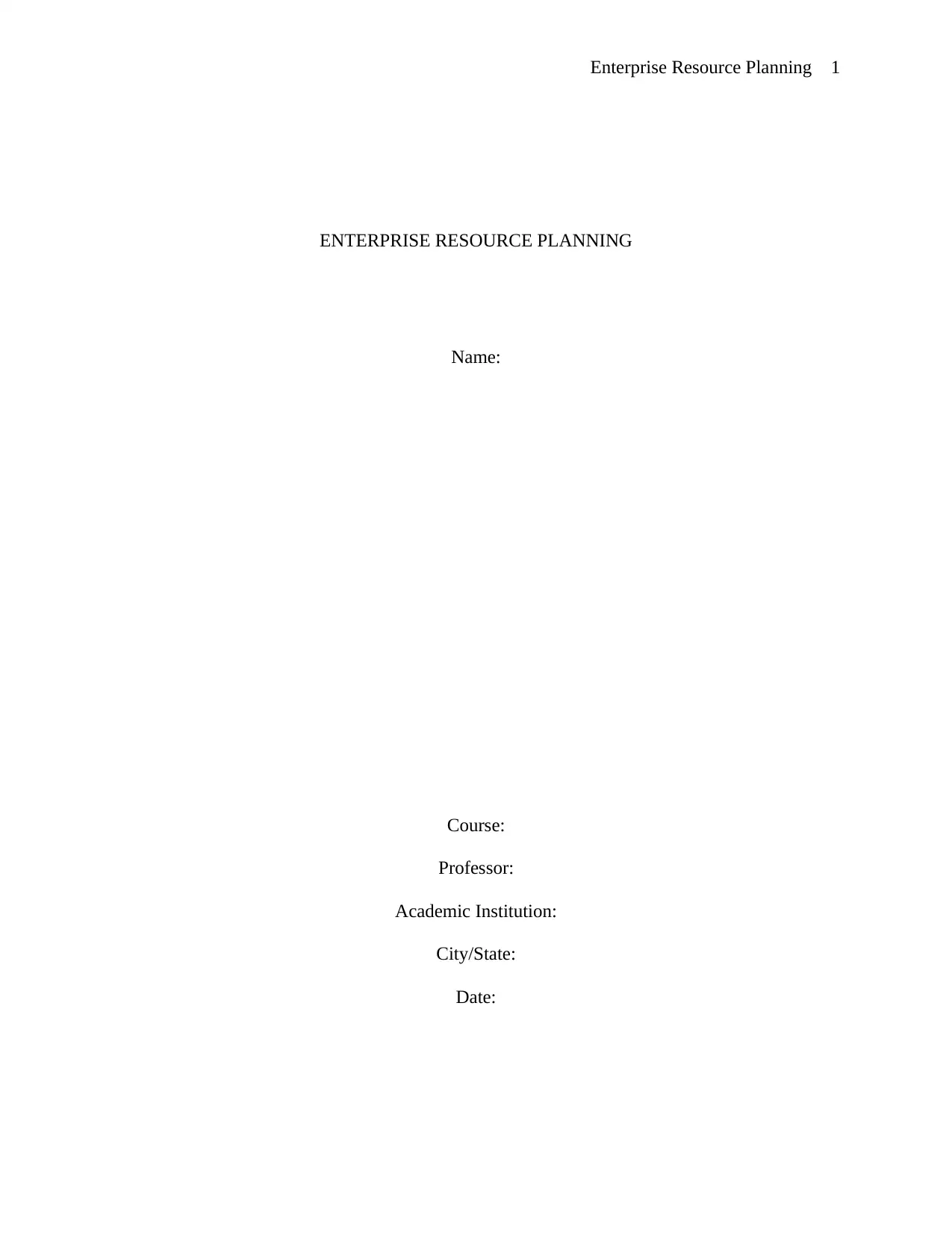
Enterprise Resource Planning 1
ENTERPRISE RESOURCE PLANNING
Name:
Course:
Professor:
Academic Institution:
City/State:
Date:
ENTERPRISE RESOURCE PLANNING
Name:
Course:
Professor:
Academic Institution:
City/State:
Date:
Paraphrase This Document
Need a fresh take? Get an instant paraphrase of this document with our AI Paraphraser
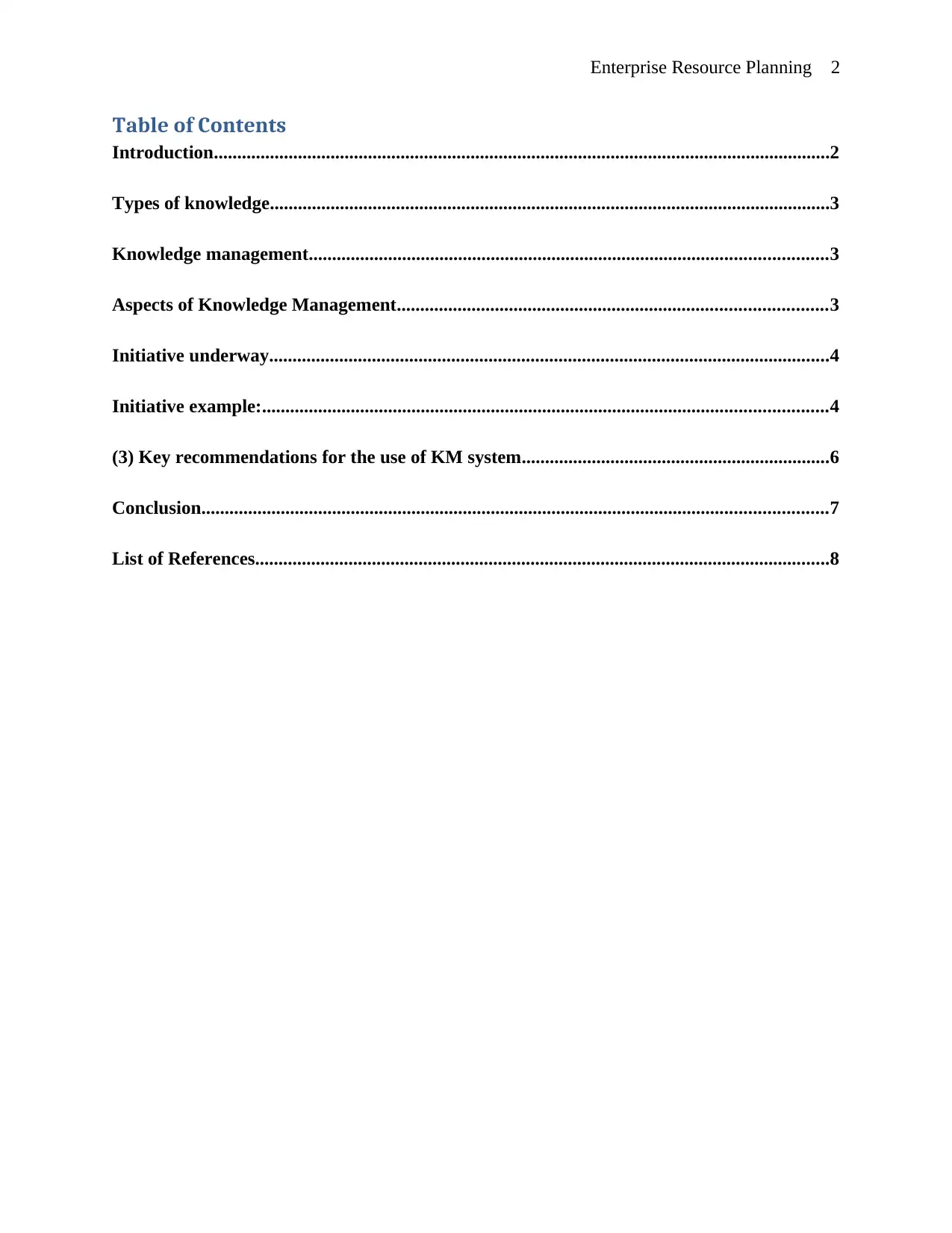
Enterprise Resource Planning 2
Table of Contents
Introduction....................................................................................................................................2
Types of knowledge........................................................................................................................3
Knowledge management...............................................................................................................3
Aspects of Knowledge Management............................................................................................3
Initiative underway........................................................................................................................4
Initiative example:.........................................................................................................................4
(3) Key recommendations for the use of KM system..................................................................6
Conclusion......................................................................................................................................7
List of References...........................................................................................................................8
Table of Contents
Introduction....................................................................................................................................2
Types of knowledge........................................................................................................................3
Knowledge management...............................................................................................................3
Aspects of Knowledge Management............................................................................................3
Initiative underway........................................................................................................................4
Initiative example:.........................................................................................................................4
(3) Key recommendations for the use of KM system..................................................................6
Conclusion......................................................................................................................................7
List of References...........................................................................................................................8
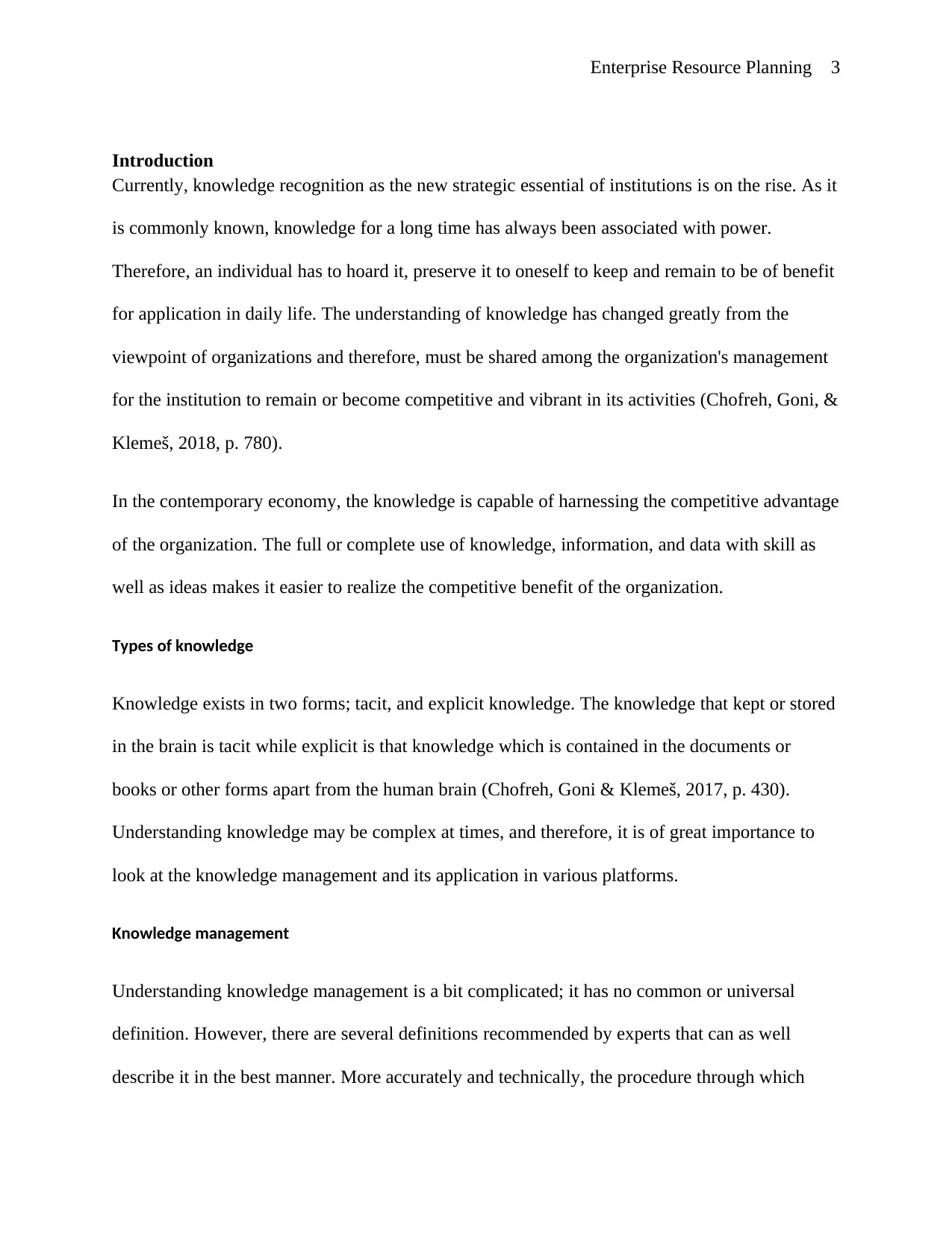
Enterprise Resource Planning 3
Introduction
Currently, knowledge recognition as the new strategic essential of institutions is on the rise. As it
is commonly known, knowledge for a long time has always been associated with power.
Therefore, an individual has to hoard it, preserve it to oneself to keep and remain to be of benefit
for application in daily life. The understanding of knowledge has changed greatly from the
viewpoint of organizations and therefore, must be shared among the organization's management
for the institution to remain or become competitive and vibrant in its activities (Chofreh, Goni, &
Klemeš, 2018, p. 780).
In the contemporary economy, the knowledge is capable of harnessing the competitive advantage
of the organization. The full or complete use of knowledge, information, and data with skill as
well as ideas makes it easier to realize the competitive benefit of the organization.
Types of knowledge
Knowledge exists in two forms; tacit, and explicit knowledge. The knowledge that kept or stored
in the brain is tacit while explicit is that knowledge which is contained in the documents or
books or other forms apart from the human brain (Chofreh, Goni & Klemeš, 2017, p. 430).
Understanding knowledge may be complex at times, and therefore, it is of great importance to
look at the knowledge management and its application in various platforms.
Knowledge management
Understanding knowledge management is a bit complicated; it has no common or universal
definition. However, there are several definitions recommended by experts that can as well
describe it in the best manner. More accurately and technically, the procedure through which
Introduction
Currently, knowledge recognition as the new strategic essential of institutions is on the rise. As it
is commonly known, knowledge for a long time has always been associated with power.
Therefore, an individual has to hoard it, preserve it to oneself to keep and remain to be of benefit
for application in daily life. The understanding of knowledge has changed greatly from the
viewpoint of organizations and therefore, must be shared among the organization's management
for the institution to remain or become competitive and vibrant in its activities (Chofreh, Goni, &
Klemeš, 2018, p. 780).
In the contemporary economy, the knowledge is capable of harnessing the competitive advantage
of the organization. The full or complete use of knowledge, information, and data with skill as
well as ideas makes it easier to realize the competitive benefit of the organization.
Types of knowledge
Knowledge exists in two forms; tacit, and explicit knowledge. The knowledge that kept or stored
in the brain is tacit while explicit is that knowledge which is contained in the documents or
books or other forms apart from the human brain (Chofreh, Goni & Klemeš, 2017, p. 430).
Understanding knowledge may be complex at times, and therefore, it is of great importance to
look at the knowledge management and its application in various platforms.
Knowledge management
Understanding knowledge management is a bit complicated; it has no common or universal
definition. However, there are several definitions recommended by experts that can as well
describe it in the best manner. More accurately and technically, the procedure through which
⊘ This is a preview!⊘
Do you want full access?
Subscribe today to unlock all pages.

Trusted by 1+ million students worldwide
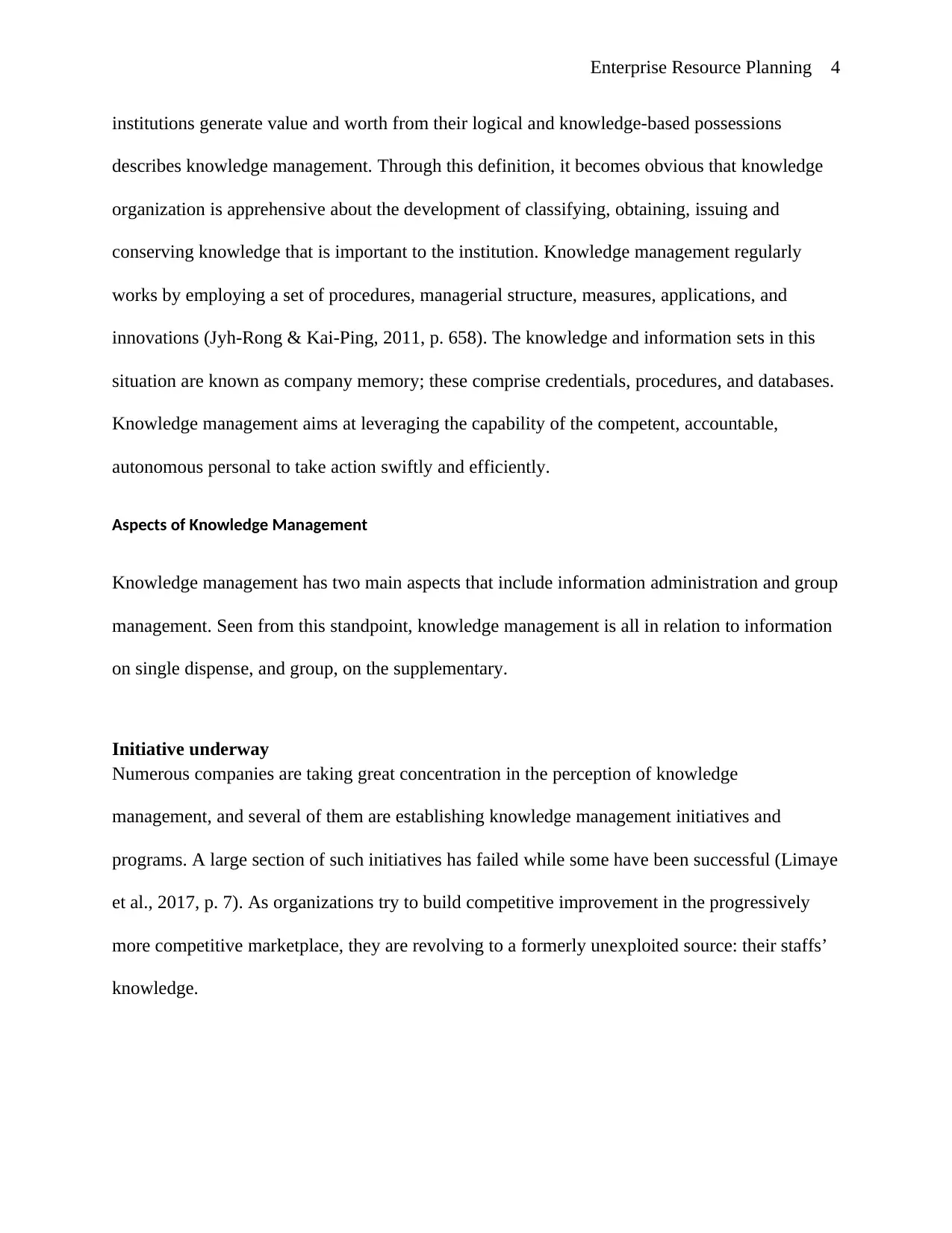
Enterprise Resource Planning 4
institutions generate value and worth from their logical and knowledge-based possessions
describes knowledge management. Through this definition, it becomes obvious that knowledge
organization is apprehensive about the development of classifying, obtaining, issuing and
conserving knowledge that is important to the institution. Knowledge management regularly
works by employing a set of procedures, managerial structure, measures, applications, and
innovations (Jyh-Rong & Kai-Ping, 2011, p. 658). The knowledge and information sets in this
situation are known as company memory; these comprise credentials, procedures, and databases.
Knowledge management aims at leveraging the capability of the competent, accountable,
autonomous personal to take action swiftly and efficiently.
Aspects of Knowledge Management
Knowledge management has two main aspects that include information administration and group
management. Seen from this standpoint, knowledge management is all in relation to information
on single dispense, and group, on the supplementary.
Initiative underway
Numerous companies are taking great concentration in the perception of knowledge
management, and several of them are establishing knowledge management initiatives and
programs. A large section of such initiatives has failed while some have been successful (Limaye
et al., 2017, p. 7). As organizations try to build competitive improvement in the progressively
more competitive marketplace, they are revolving to a formerly unexploited source: their staffs’
knowledge.
institutions generate value and worth from their logical and knowledge-based possessions
describes knowledge management. Through this definition, it becomes obvious that knowledge
organization is apprehensive about the development of classifying, obtaining, issuing and
conserving knowledge that is important to the institution. Knowledge management regularly
works by employing a set of procedures, managerial structure, measures, applications, and
innovations (Jyh-Rong & Kai-Ping, 2011, p. 658). The knowledge and information sets in this
situation are known as company memory; these comprise credentials, procedures, and databases.
Knowledge management aims at leveraging the capability of the competent, accountable,
autonomous personal to take action swiftly and efficiently.
Aspects of Knowledge Management
Knowledge management has two main aspects that include information administration and group
management. Seen from this standpoint, knowledge management is all in relation to information
on single dispense, and group, on the supplementary.
Initiative underway
Numerous companies are taking great concentration in the perception of knowledge
management, and several of them are establishing knowledge management initiatives and
programs. A large section of such initiatives has failed while some have been successful (Limaye
et al., 2017, p. 7). As organizations try to build competitive improvement in the progressively
more competitive marketplace, they are revolving to a formerly unexploited source: their staffs’
knowledge.
Paraphrase This Document
Need a fresh take? Get an instant paraphrase of this document with our AI Paraphraser
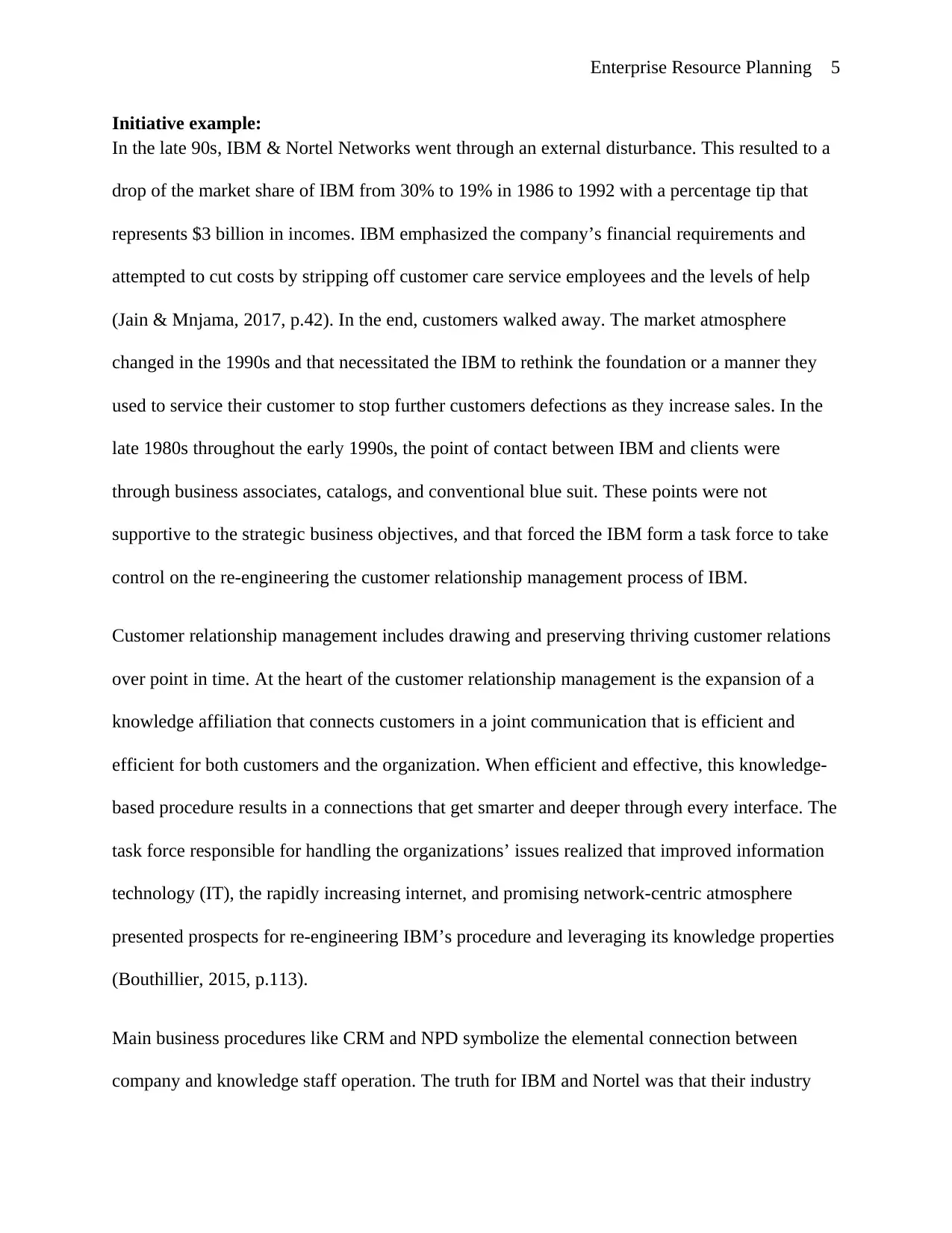
Enterprise Resource Planning 5
Initiative example:
In the late 90s, IBM & Nortel Networks went through an external disturbance. This resulted to a
drop of the market share of IBM from 30% to 19% in 1986 to 1992 with a percentage tip that
represents $3 billion in incomes. IBM emphasized the company’s financial requirements and
attempted to cut costs by stripping off customer care service employees and the levels of help
(Jain & Mnjama, 2017, p.42). In the end, customers walked away. The market atmosphere
changed in the 1990s and that necessitated the IBM to rethink the foundation or a manner they
used to service their customer to stop further customers defections as they increase sales. In the
late 1980s throughout the early 1990s, the point of contact between IBM and clients were
through business associates, catalogs, and conventional blue suit. These points were not
supportive to the strategic business objectives, and that forced the IBM form a task force to take
control on the re-engineering the customer relationship management process of IBM.
Customer relationship management includes drawing and preserving thriving customer relations
over point in time. At the heart of the customer relationship management is the expansion of a
knowledge affiliation that connects customers in a joint communication that is efficient and
efficient for both customers and the organization. When efficient and effective, this knowledge-
based procedure results in a connections that get smarter and deeper through every interface. The
task force responsible for handling the organizations’ issues realized that improved information
technology (IT), the rapidly increasing internet, and promising network-centric atmosphere
presented prospects for re-engineering IBM’s procedure and leveraging its knowledge properties
(Bouthillier, 2015, p.113).
Main business procedures like CRM and NPD symbolize the elemental connection between
company and knowledge staff operation. The truth for IBM and Nortel was that their industry
Initiative example:
In the late 90s, IBM & Nortel Networks went through an external disturbance. This resulted to a
drop of the market share of IBM from 30% to 19% in 1986 to 1992 with a percentage tip that
represents $3 billion in incomes. IBM emphasized the company’s financial requirements and
attempted to cut costs by stripping off customer care service employees and the levels of help
(Jain & Mnjama, 2017, p.42). In the end, customers walked away. The market atmosphere
changed in the 1990s and that necessitated the IBM to rethink the foundation or a manner they
used to service their customer to stop further customers defections as they increase sales. In the
late 1980s throughout the early 1990s, the point of contact between IBM and clients were
through business associates, catalogs, and conventional blue suit. These points were not
supportive to the strategic business objectives, and that forced the IBM form a task force to take
control on the re-engineering the customer relationship management process of IBM.
Customer relationship management includes drawing and preserving thriving customer relations
over point in time. At the heart of the customer relationship management is the expansion of a
knowledge affiliation that connects customers in a joint communication that is efficient and
efficient for both customers and the organization. When efficient and effective, this knowledge-
based procedure results in a connections that get smarter and deeper through every interface. The
task force responsible for handling the organizations’ issues realized that improved information
technology (IT), the rapidly increasing internet, and promising network-centric atmosphere
presented prospects for re-engineering IBM’s procedure and leveraging its knowledge properties
(Bouthillier, 2015, p.113).
Main business procedures like CRM and NPD symbolize the elemental connection between
company and knowledge staff operation. The truth for IBM and Nortel was that their industry
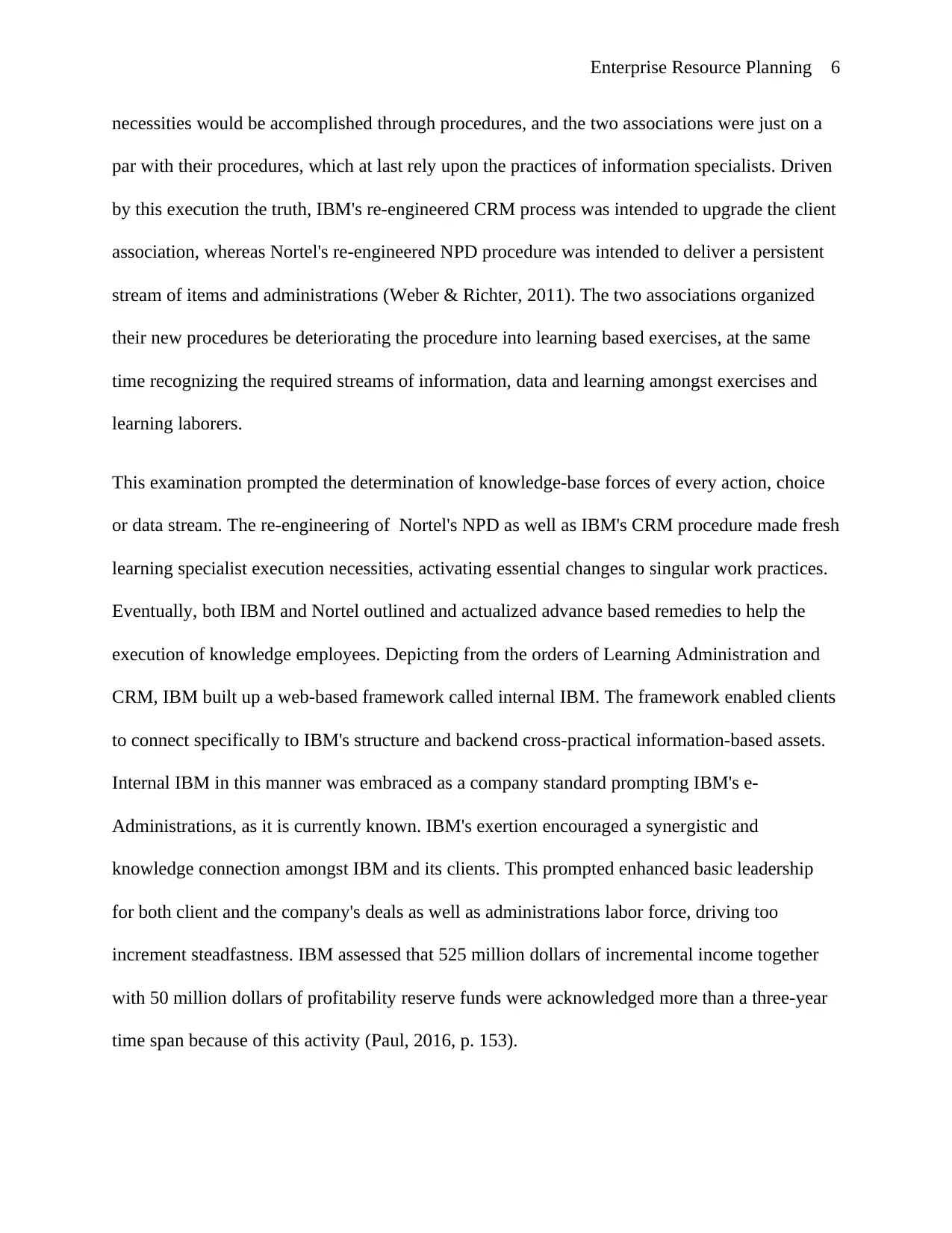
Enterprise Resource Planning 6
necessities would be accomplished through procedures, and the two associations were just on a
par with their procedures, which at last rely upon the practices of information specialists. Driven
by this execution the truth, IBM's re-engineered CRM process was intended to upgrade the client
association, whereas Nortel's re-engineered NPD procedure was intended to deliver a persistent
stream of items and administrations (Weber & Richter, 2011). The two associations organized
their new procedures be deteriorating the procedure into learning based exercises, at the same
time recognizing the required streams of information, data and learning amongst exercises and
learning laborers.
This examination prompted the determination of knowledge-base forces of every action, choice
or data stream. The re-engineering of Nortel's NPD as well as IBM's CRM procedure made fresh
learning specialist execution necessities, activating essential changes to singular work practices.
Eventually, both IBM and Nortel outlined and actualized advance based remedies to help the
execution of knowledge employees. Depicting from the orders of Learning Administration and
CRM, IBM built up a web-based framework called internal IBM. The framework enabled clients
to connect specifically to IBM's structure and backend cross-practical information-based assets.
Internal IBM in this manner was embraced as a company standard prompting IBM's e-
Administrations, as it is currently known. IBM's exertion encouraged a synergistic and
knowledge connection amongst IBM and its clients. This prompted enhanced basic leadership
for both client and the company's deals as well as administrations labor force, driving too
increment steadfastness. IBM assessed that 525 million dollars of incremental income together
with 50 million dollars of profitability reserve funds were acknowledged more than a three-year
time span because of this activity (Paul, 2016, p. 153).
necessities would be accomplished through procedures, and the two associations were just on a
par with their procedures, which at last rely upon the practices of information specialists. Driven
by this execution the truth, IBM's re-engineered CRM process was intended to upgrade the client
association, whereas Nortel's re-engineered NPD procedure was intended to deliver a persistent
stream of items and administrations (Weber & Richter, 2011). The two associations organized
their new procedures be deteriorating the procedure into learning based exercises, at the same
time recognizing the required streams of information, data and learning amongst exercises and
learning laborers.
This examination prompted the determination of knowledge-base forces of every action, choice
or data stream. The re-engineering of Nortel's NPD as well as IBM's CRM procedure made fresh
learning specialist execution necessities, activating essential changes to singular work practices.
Eventually, both IBM and Nortel outlined and actualized advance based remedies to help the
execution of knowledge employees. Depicting from the orders of Learning Administration and
CRM, IBM built up a web-based framework called internal IBM. The framework enabled clients
to connect specifically to IBM's structure and backend cross-practical information-based assets.
Internal IBM in this manner was embraced as a company standard prompting IBM's e-
Administrations, as it is currently known. IBM's exertion encouraged a synergistic and
knowledge connection amongst IBM and its clients. This prompted enhanced basic leadership
for both client and the company's deals as well as administrations labor force, driving too
increment steadfastness. IBM assessed that 525 million dollars of incremental income together
with 50 million dollars of profitability reserve funds were acknowledged more than a three-year
time span because of this activity (Paul, 2016, p. 153).
⊘ This is a preview!⊘
Do you want full access?
Subscribe today to unlock all pages.

Trusted by 1+ million students worldwide
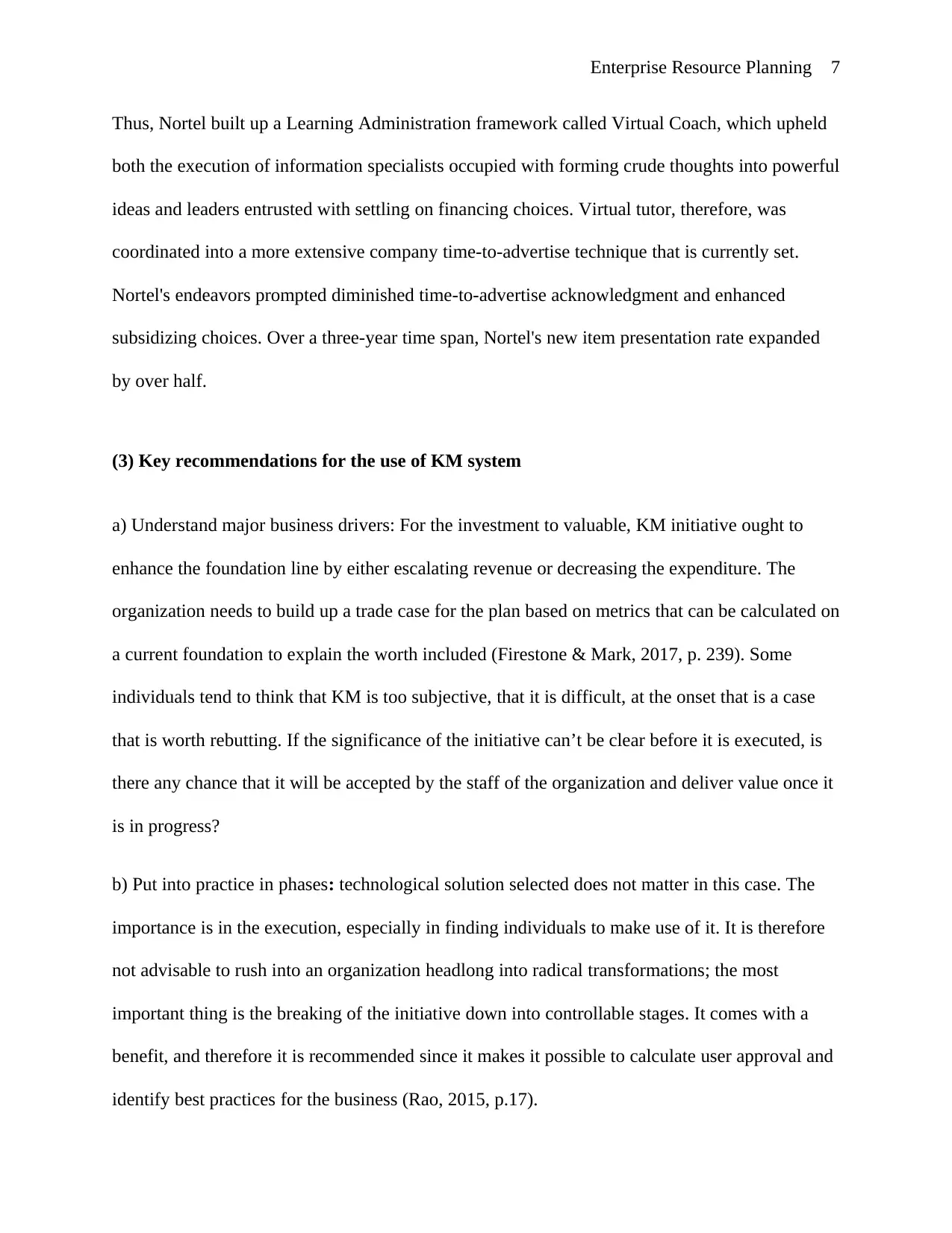
Enterprise Resource Planning 7
Thus, Nortel built up a Learning Administration framework called Virtual Coach, which upheld
both the execution of information specialists occupied with forming crude thoughts into powerful
ideas and leaders entrusted with settling on financing choices. Virtual tutor, therefore, was
coordinated into a more extensive company time-to-advertise technique that is currently set.
Nortel's endeavors prompted diminished time-to-advertise acknowledgment and enhanced
subsidizing choices. Over a three-year time span, Nortel's new item presentation rate expanded
by over half.
(3) Key recommendations for the use of KM system
a) Understand major business drivers: For the investment to valuable, KM initiative ought to
enhance the foundation line by either escalating revenue or decreasing the expenditure. The
organization needs to build up a trade case for the plan based on metrics that can be calculated on
a current foundation to explain the worth included (Firestone & Mark, 2017, p. 239). Some
individuals tend to think that KM is too subjective, that it is difficult, at the onset that is a case
that is worth rebutting. If the significance of the initiative can’t be clear before it is executed, is
there any chance that it will be accepted by the staff of the organization and deliver value once it
is in progress?
b) Put into practice in phases: technological solution selected does not matter in this case. The
importance is in the execution, especially in finding individuals to make use of it. It is therefore
not advisable to rush into an organization headlong into radical transformations; the most
important thing is the breaking of the initiative down into controllable stages. It comes with a
benefit, and therefore it is recommended since it makes it possible to calculate user approval and
identify best practices for the business (Rao, 2015, p.17).
Thus, Nortel built up a Learning Administration framework called Virtual Coach, which upheld
both the execution of information specialists occupied with forming crude thoughts into powerful
ideas and leaders entrusted with settling on financing choices. Virtual tutor, therefore, was
coordinated into a more extensive company time-to-advertise technique that is currently set.
Nortel's endeavors prompted diminished time-to-advertise acknowledgment and enhanced
subsidizing choices. Over a three-year time span, Nortel's new item presentation rate expanded
by over half.
(3) Key recommendations for the use of KM system
a) Understand major business drivers: For the investment to valuable, KM initiative ought to
enhance the foundation line by either escalating revenue or decreasing the expenditure. The
organization needs to build up a trade case for the plan based on metrics that can be calculated on
a current foundation to explain the worth included (Firestone & Mark, 2017, p. 239). Some
individuals tend to think that KM is too subjective, that it is difficult, at the onset that is a case
that is worth rebutting. If the significance of the initiative can’t be clear before it is executed, is
there any chance that it will be accepted by the staff of the organization and deliver value once it
is in progress?
b) Put into practice in phases: technological solution selected does not matter in this case. The
importance is in the execution, especially in finding individuals to make use of it. It is therefore
not advisable to rush into an organization headlong into radical transformations; the most
important thing is the breaking of the initiative down into controllable stages. It comes with a
benefit, and therefore it is recommended since it makes it possible to calculate user approval and
identify best practices for the business (Rao, 2015, p.17).
Paraphrase This Document
Need a fresh take? Get an instant paraphrase of this document with our AI Paraphraser
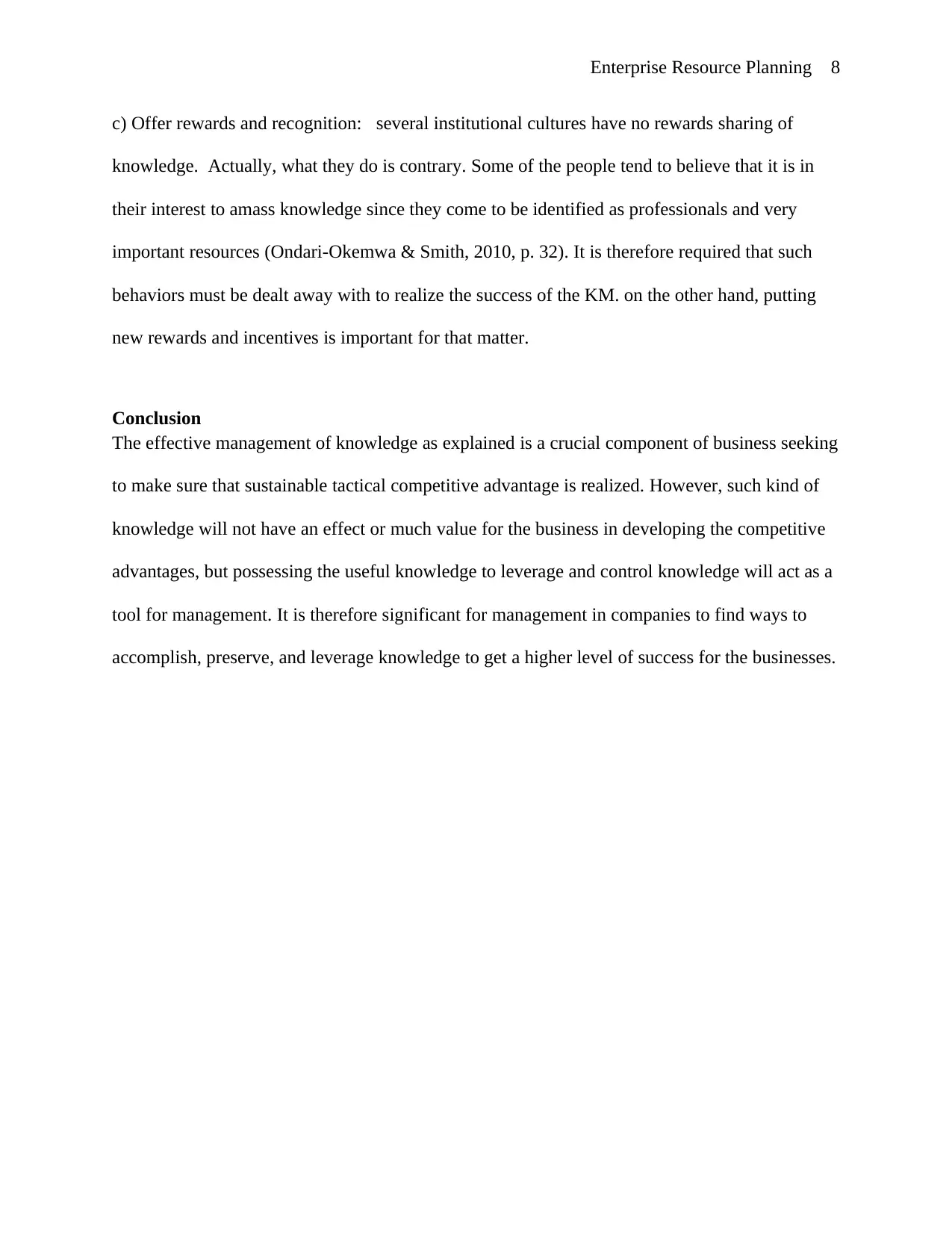
Enterprise Resource Planning 8
c) Offer rewards and recognition: several institutional cultures have no rewards sharing of
knowledge. Actually, what they do is contrary. Some of the people tend to believe that it is in
their interest to amass knowledge since they come to be identified as professionals and very
important resources (Ondari-Okemwa & Smith, 2010, p. 32). It is therefore required that such
behaviors must be dealt away with to realize the success of the KM. on the other hand, putting
new rewards and incentives is important for that matter.
Conclusion
The effective management of knowledge as explained is a crucial component of business seeking
to make sure that sustainable tactical competitive advantage is realized. However, such kind of
knowledge will not have an effect or much value for the business in developing the competitive
advantages, but possessing the useful knowledge to leverage and control knowledge will act as a
tool for management. It is therefore significant for management in companies to find ways to
accomplish, preserve, and leverage knowledge to get a higher level of success for the businesses.
c) Offer rewards and recognition: several institutional cultures have no rewards sharing of
knowledge. Actually, what they do is contrary. Some of the people tend to believe that it is in
their interest to amass knowledge since they come to be identified as professionals and very
important resources (Ondari-Okemwa & Smith, 2010, p. 32). It is therefore required that such
behaviors must be dealt away with to realize the success of the KM. on the other hand, putting
new rewards and incentives is important for that matter.
Conclusion
The effective management of knowledge as explained is a crucial component of business seeking
to make sure that sustainable tactical competitive advantage is realized. However, such kind of
knowledge will not have an effect or much value for the business in developing the competitive
advantages, but possessing the useful knowledge to leverage and control knowledge will act as a
tool for management. It is therefore significant for management in companies to find ways to
accomplish, preserve, and leverage knowledge to get a higher level of success for the businesses.
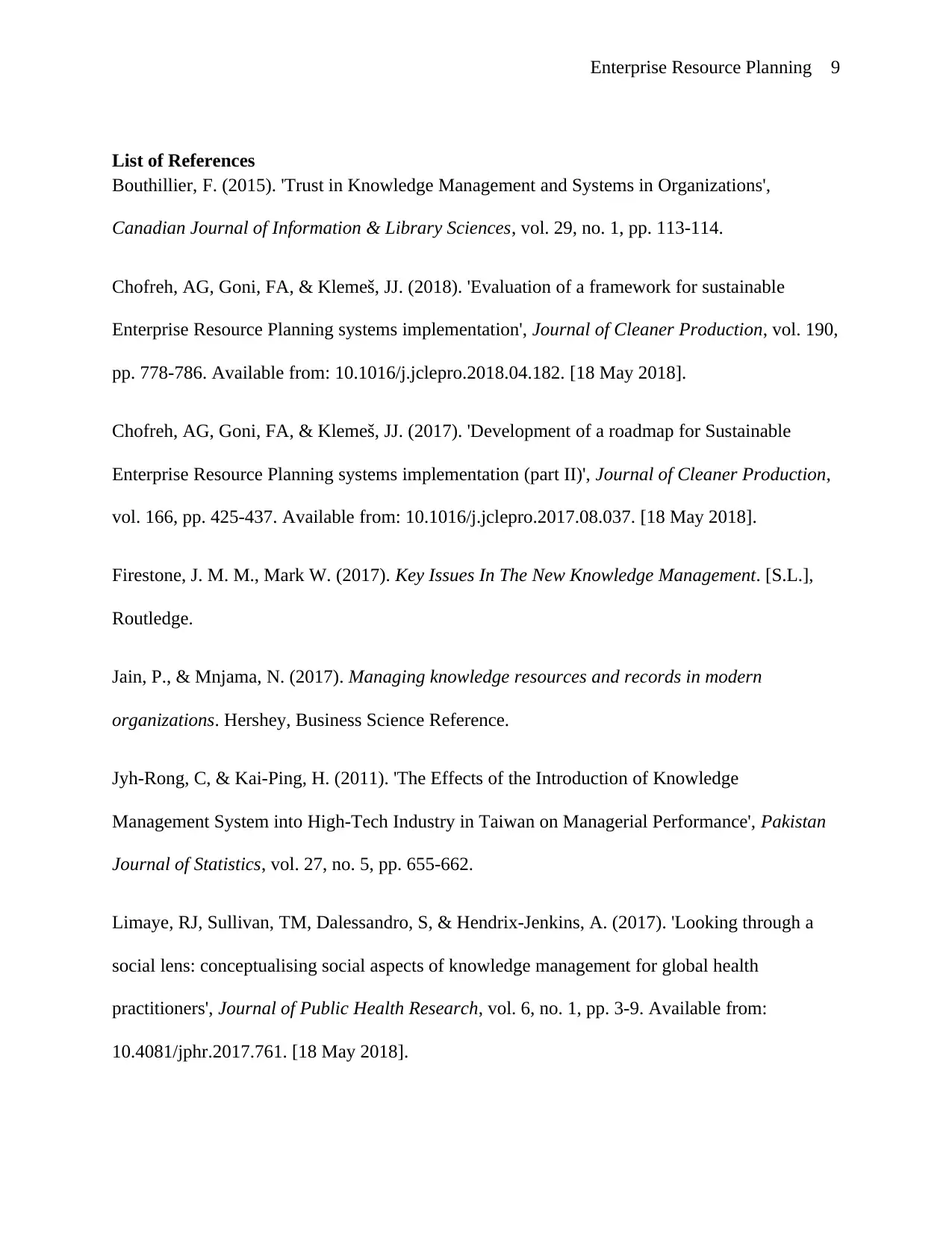
Enterprise Resource Planning 9
List of References
Bouthillier, F. (2015). 'Trust in Knowledge Management and Systems in Organizations',
Canadian Journal of Information & Library Sciences, vol. 29, no. 1, pp. 113-114.
Chofreh, AG, Goni, FA, & Klemeš, JJ. (2018). 'Evaluation of a framework for sustainable
Enterprise Resource Planning systems implementation', Journal of Cleaner Production, vol. 190,
pp. 778-786. Available from: 10.1016/j.jclepro.2018.04.182. [18 May 2018].
Chofreh, AG, Goni, FA, & Klemeš, JJ. (2017). 'Development of a roadmap for Sustainable
Enterprise Resource Planning systems implementation (part II)', Journal of Cleaner Production,
vol. 166, pp. 425-437. Available from: 10.1016/j.jclepro.2017.08.037. [18 May 2018].
Firestone, J. M. M., Mark W. (2017). Key Issues In The New Knowledge Management. [S.L.],
Routledge.
Jain, P., & Mnjama, N. (2017). Managing knowledge resources and records in modern
organizations. Hershey, Business Science Reference.
Jyh-Rong, C, & Kai-Ping, H. (2011). 'The Effects of the Introduction of Knowledge
Management System into High-Tech Industry in Taiwan on Managerial Performance', Pakistan
Journal of Statistics, vol. 27, no. 5, pp. 655-662.
Limaye, RJ, Sullivan, TM, Dalessandro, S, & Hendrix-Jenkins, A. (2017). 'Looking through a
social lens: conceptualising social aspects of knowledge management for global health
practitioners', Journal of Public Health Research, vol. 6, no. 1, pp. 3-9. Available from:
10.4081/jphr.2017.761. [18 May 2018].
List of References
Bouthillier, F. (2015). 'Trust in Knowledge Management and Systems in Organizations',
Canadian Journal of Information & Library Sciences, vol. 29, no. 1, pp. 113-114.
Chofreh, AG, Goni, FA, & Klemeš, JJ. (2018). 'Evaluation of a framework for sustainable
Enterprise Resource Planning systems implementation', Journal of Cleaner Production, vol. 190,
pp. 778-786. Available from: 10.1016/j.jclepro.2018.04.182. [18 May 2018].
Chofreh, AG, Goni, FA, & Klemeš, JJ. (2017). 'Development of a roadmap for Sustainable
Enterprise Resource Planning systems implementation (part II)', Journal of Cleaner Production,
vol. 166, pp. 425-437. Available from: 10.1016/j.jclepro.2017.08.037. [18 May 2018].
Firestone, J. M. M., Mark W. (2017). Key Issues In The New Knowledge Management. [S.L.],
Routledge.
Jain, P., & Mnjama, N. (2017). Managing knowledge resources and records in modern
organizations. Hershey, Business Science Reference.
Jyh-Rong, C, & Kai-Ping, H. (2011). 'The Effects of the Introduction of Knowledge
Management System into High-Tech Industry in Taiwan on Managerial Performance', Pakistan
Journal of Statistics, vol. 27, no. 5, pp. 655-662.
Limaye, RJ, Sullivan, TM, Dalessandro, S, & Hendrix-Jenkins, A. (2017). 'Looking through a
social lens: conceptualising social aspects of knowledge management for global health
practitioners', Journal of Public Health Research, vol. 6, no. 1, pp. 3-9. Available from:
10.4081/jphr.2017.761. [18 May 2018].
⊘ This is a preview!⊘
Do you want full access?
Subscribe today to unlock all pages.

Trusted by 1+ million students worldwide
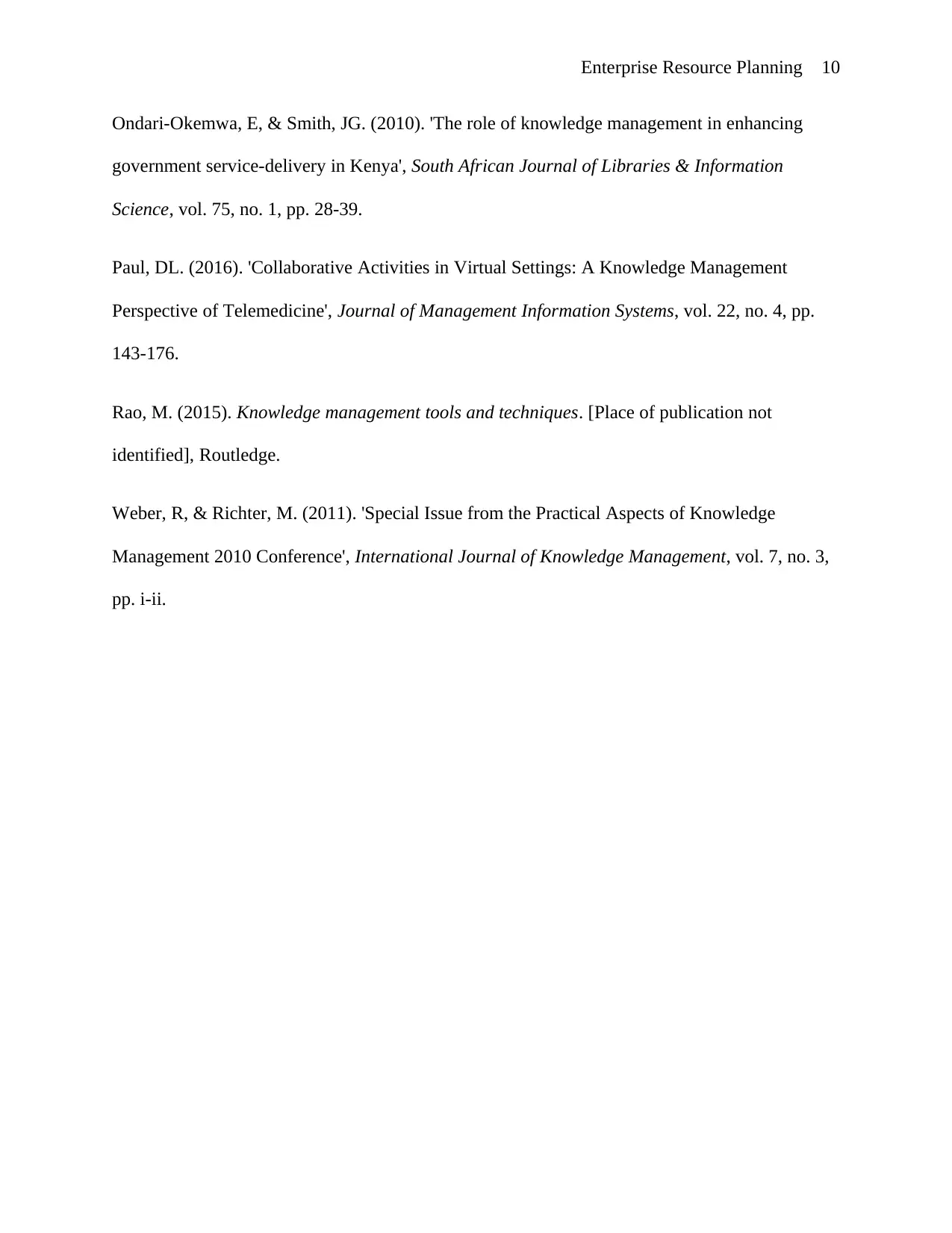
Enterprise Resource Planning 10
Ondari-Okemwa, E, & Smith, JG. (2010). 'The role of knowledge management in enhancing
government service-delivery in Kenya', South African Journal of Libraries & Information
Science, vol. 75, no. 1, pp. 28-39.
Paul, DL. (2016). 'Collaborative Activities in Virtual Settings: A Knowledge Management
Perspective of Telemedicine', Journal of Management Information Systems, vol. 22, no. 4, pp.
143-176.
Rao, M. (2015). Knowledge management tools and techniques. [Place of publication not
identified], Routledge.
Weber, R, & Richter, M. (2011). 'Special Issue from the Practical Aspects of Knowledge
Management 2010 Conference', International Journal of Knowledge Management, vol. 7, no. 3,
pp. i-ii.
Ondari-Okemwa, E, & Smith, JG. (2010). 'The role of knowledge management in enhancing
government service-delivery in Kenya', South African Journal of Libraries & Information
Science, vol. 75, no. 1, pp. 28-39.
Paul, DL. (2016). 'Collaborative Activities in Virtual Settings: A Knowledge Management
Perspective of Telemedicine', Journal of Management Information Systems, vol. 22, no. 4, pp.
143-176.
Rao, M. (2015). Knowledge management tools and techniques. [Place of publication not
identified], Routledge.
Weber, R, & Richter, M. (2011). 'Special Issue from the Practical Aspects of Knowledge
Management 2010 Conference', International Journal of Knowledge Management, vol. 7, no. 3,
pp. i-ii.
1 out of 10
Related Documents
Your All-in-One AI-Powered Toolkit for Academic Success.
+13062052269
info@desklib.com
Available 24*7 on WhatsApp / Email
![[object Object]](/_next/static/media/star-bottom.7253800d.svg)
Unlock your academic potential
Copyright © 2020–2025 A2Z Services. All Rights Reserved. Developed and managed by ZUCOL.





